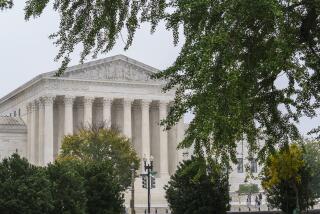Same-sex marriage: Supreme Court Justices don’t know much about history
The most interesting, and dispiriting, aspect of Tuesday’s Supreme Court arguments on same-sex marriage was the absence in the court chamber of any real understanding of the history of marriage.
Several justices, including Chief Justice John Roberts, seemed to have the impression that the “definition” of marriage has been fixed for “millennia.” Their goal, plainly, was to make an accommodation of same-sex marriage seem a far more momentous step than it really is. “It’s very difficult for the court to say, oh, well, we--we know better,” said Justice Anthony Kennedy.
One hopes, on reading the transcript, to find Mary Bonauto, the lawyer for the petitioners, set them straight. One hopes in vain. Bonauto may have been taking a strategic tack here--it might not do to tell Supreme Court Justices citing historical norms that they don’t know what they’re talking about, and safer to resort to more conventional arguments of equal protection and nondiscrimination.
The consensus of court watchers is that the court will overturn same-sex marriage bans nationwide by a 5-4 vote. That’s encouraging, but the tenor of the discussion was still disturbingly ahistorical.
Where did the justices get the idea that the definition of marriage has been fixed for any period of time, much less “millennia”? What are the grounds for accepting any one culture’s definition at any one point as the immutable definition of “marriage”? The historical and cultural evidence is exactly the opposite, and the scholarship long has been available in historical studies, press reports and books.
Among the more recent of the latter are Marriage: A History, by Stephanie Coontz (2005), and A History of the Wife, by Marilyn Yalom (2001). Both make it plain that of all our social institutions, marriage may have been among the most flexible over the millennia. In definition and practice, it has evolved and devolved to meet economic and political demands, shifting cultural norms and biological imperatives. The mandate of procreation to preserve the human race has always been part of the definition of marriage, certainly, but rarely the only goal or, in some cases, even the principal one.
As Coontz writes, the notion of marriage as the creation of a family unit living together--man, woman, children--is by no means a global cultural standard and is even frowned on in some communities as unduly isolating. Polygamous marriages were legal in some American communities through the late 19th century, and according to some legal holdings, still are. And in other parts of the world and other times, the practice was by no means uncommon.
In some societies the institution has been seen as an economic transaction, with the daughter as the medium of exchange; the duties of husband to wife and vice versa, and their mutual rights regarding each other, have been changing right up to to present-day American jurisprudence. The notion of marriage as an emotional bond--the love match, especially without the participation or approval of the parents--is a fairly modern development.
In Shakespeare’s plays alone one finds a kaleidoscope of purposes for marriage--for love, for dynastic purpose, for spite, for sex. Procreation? In All’s Well that Ends Well, one can argue that the marriage at the center of the plot is undertaken to avoid procreation. The critic Harold Bloom mischievously asserts that the closest, most loving marriage in all of Shakespeare is that of the Macbeths. Who would hold up that relationship as a model?
One of the last-ditch arguments of the anti-same-sex litigants before the Supreme Court--that the state’s interest in the definition of marriage stems from its interest in regulating and promoting procreation -- was conclusively demolished last year by U.S. Appeals Judge Richard Posner of Chicago, both during oral arguments before his court and in his ringing opinion overturning same-sex marriage bans in Indiana and Wisconsin. “Why does Indiana let sterile people marry?” he asked Indiana Solicitor General Thomas Fisher, who didn’t have a good answer.
What all this shows is that the definition of marriage has been cut and recut to meet the needs and norms of societies the world over and since time immemorial--indeed, for millennia.
In America today, restricting marriage to a man and woman is incompatible with our norms of civil rights and the legal rights of the excluded persons. Outlawing same-sex marriage as nontraditional won’t do, as Posner observed:
“There are good traditions, bad traditions...bad traditions that are historical realities such as cannibalism, foot-binding, and suttee....Tradition per se therefore cannot be a lawful ground for discrimination--regardless of the age of the tradition.”
It’s even worse when the “tradition” being appealed to doesn’t exist at all, as is the case with the traditional definition of marriage cited by Chief Justice Roberts this week. “Every definition that I looked up, prior to about a dozen years ago,” he remarked during the oral arguments, “defined marriage as unity between a man and a woman as husband and wife.” He must not have looked very far.
Keep up to date with the Economy Hub. Follow @hiltzikm on Twitter, see our Facebook page, or email mhiltzik@latimes.com.







